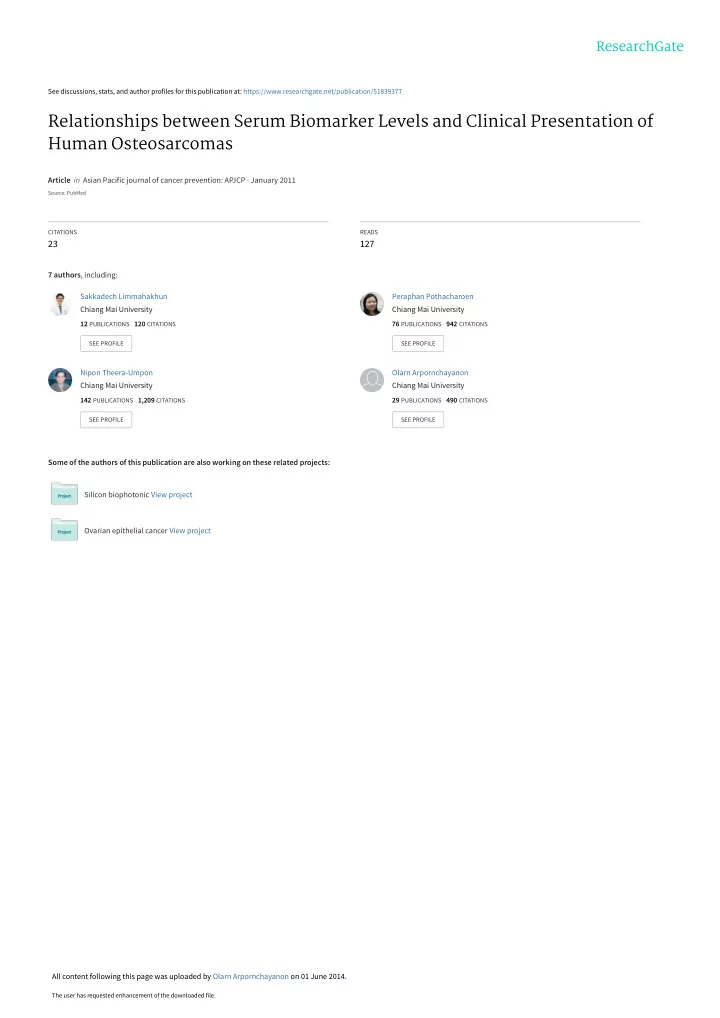

See discussions, stats, and author profiles for this publication at: https://www.researchgate.net/publication/51839377 Relationships between Serum Biomarker Levels and Clinical Presentation of Human Osteosarcomas Article in Asian Pacific journal of cancer prevention: APJCP · January 2011 Source: PubMed CITATIONS READS 23 127 7 authors , including: Sakkadech Limmahakhun Peraphan Pothacharoen Chiang Mai University Chiang Mai University 12 PUBLICATIONS 120 CITATIONS 76 PUBLICATIONS 942 CITATIONS SEE PROFILE SEE PROFILE Nipon Theera-Umpon Olarn Arpornchayanon Chiang Mai University Chiang Mai University 142 PUBLICATIONS 1,209 CITATIONS 29 PUBLICATIONS 490 CITATIONS SEE PROFILE SEE PROFILE Some of the authors of this publication are also working on these related projects: Silicon biophotonic View project Ovarian epithelial cancer View project All content following this page was uploaded by Olarn Arpornchayanon on 01 June 2014. The user has requested enhancement of the downloaded file.
Serum Biomarker Levels and Clinical Presentation of Human Osteosarcomas R ESEARCH COMMUNICATION Relationships between Serum Biomarker Levels and Clinical Presentation of Human Osteosarcomas Sakkadech Limmahakhun 1 , Peraphan Pothacharoen 2 , Nipon Theera-Umpon 3,4 , Olarn Arpornchayanon 1 , Taninnit Leerapun 1 , Sirichai Luevitoonvechkij 1 , Dumnoensun Pruksakorn 1 * Abstract Background: Currently, serum biomarkers play an important role as sensitive tools for monitoring the cancer development and progression. Each biomarker represents a specifjc pathogenesis and has different predictive capability. In order to identify their characteristics in human osteosarcoma, multiple potential biomarkers were analyzed simultaneously with clinical presentations. Materials and Methods: Blood samples were collected from 28 osteosarcoma patients and 30 healthy matched controls. Specifjc clinical presentations were recorded, including: tumor volume, estimated based on three-dimensional MRI volumetric measurement; metastasis status; and histological cell types. Serum biomarkers analyzed by ELISA-based assays were bone-specifjc alkaline phosphatase (BALP), vascular endothelial growth factor (VEGF), hyaluronic acid (HA) and chondroitin sulfate WF6 (WF6). Serum lactate dehydrogenase (LDH) was analyzed by a photometric-based system. Results: Serum BALP, LDH and WF6 levels of osteosarcoma patients were signifjcantly higher than those of healthy controls, whereas HA and VEGF levels were not signifjcantly different between the two groups. Serum BALP and LDH were positively correlated with tumor volume, (correlation coeffjcients 0.5 and 0.4, respectively). Serum BALP from metastasis and osteoblastic subtype group had a signifjcantly higher level than that found in non-metastasis and non-osteoblastic subtypes group, respectively. Upon multivariate analysis, tumor volume was the only factor which correlated with BALP levels. Conclusion: Of the biomarkers analyzed in this study, serum BALP was the most reliable and sensitive for estimating tumor volume. A high level of serum WF6 refmects alteration of the extracellular matrix component of tumors. Both serum biomarkers can be expected to be further explored for use in specifjc clinical monitoring. Keywords: Bone-specifjc alkaline phosphatase - osteosarcoma - tumor volume - VEGF - chondroitin sulfate - WF6 Asian Pacifjc J Cancer Prev, 12 , 1717-1722 biomarker study moreover can provide a comparative Introduction view for selecting the most potential biomarkers within Osteosarcoma is the most common malignant the specifjc clinical situation. bone tumor in adolescents and young adults. Although The poor prognosis of osteosarcoma depends on multidisciplinary approaches and limb-sparing surgeries patient- and treatment-related factors. The patient- have improved the survival rate and quality of life, a better related factors directly associate to the pathogenesis of understanding of the tumor growth and metastasis is still disease, which affects to serum biomarker levels. Tumor required for improving the future treatment strategies. volume, histological type, and metastasis status at initial Currently, serum biomarkers play an important role to be presentation have been known as the patient-related a sensitive tool for monitoring the pathogenesis of disease factors predicting the survival rate of osteosarcoma (Bacci because they are the relation between released biomakers et al., 2006). Tumor volume determines the number of from tumors and dynamic body distribution and excretion cancer cells and growth potential of the tumor in host. (Sawyers, 2008). Serum biomarker level is not always The tumor volume at initial presentation, and volume related to an expression level in local tissue. Therefore, the change after chemotherapy, are known to be signifjcant validation studies between serum biomarkers and specifjc determinants of the prognosis (Moon et al., 2005). The clinical presentation would be performed before applying initial metastasis implies the systemic burden of cancer each biomarker for clinical interpretation. Multiple cells, and the ability of cancer cells to escape from the 1 Department of Orthopedics, 2 Thailand Excellence Centre for Tissue Engineering, Department of Biochemistry, Faculty of Medicine, Chiang Mai University, 3 Department of Electrical Engineering, Faculty of Engineering, 4 Biomedical Engineering Center, Chiang Mai University, Chiang Mai 50200 Thailand *For correspondence: dumnoensun@hotmail.com 1717 Asian Pacifjc Journal of Cancer Prevention, Vol 12, 2011
Recommend
More recommend